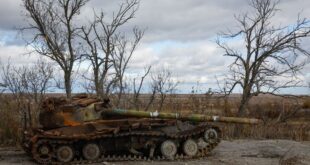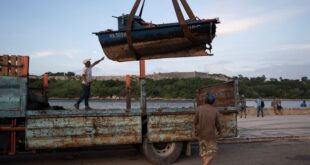SEOUL (Reuters) -North Korea flexed its military muscle with the test of a huge new solid-fuel intercontinental ballistic missile dubbed Hwasong-19, state media said on Friday, amid international uproar over its troops deployed to aid Russia in Ukraine.
The launch on Thursday flew higher than any previous North Korean missile, according to the North as well as militaries in South Korea and Japan that tracked its flight deep into space before it splashed down in the ocean between Japan and Russia.
State news agency KCNA lauded it as “the world’s strongest strategic missile.”
While questions remain over North Korea’s ability to guide such a missile and protect a nuclear warhead as it reenters the atmosphere, the Hwasong-19, like North Korea’s other latest ICBMs, demonstrated the range to strike nearly anywhere in the United States.
“The new-type ICBM proved before the world that the hegemonic position we have secured in the development and manufacture of nuclear delivery,” leader Kim Jong Un said while overseeing the launch, KCNA reported.
Thursday’s missile launch, just days before next week’s pivotal U.S. presidential election, drew swift condemnation from Washington and its allies in South Korea, Japan and Europe, as well as the United Nations Secretary-General.
Ukraine’s President Volodymyr Zelenskiy blasted what he called his allies’ “zero” response to Russia’s deployment of North Korean troops for the war in Ukraine, which has also sparked worries that Moscow could provide sensitive military technology to Pyongyang in return.
Russia and North Korea have not denied the troop deployments, and defended their right to help each other.
Defense Secretary Lloyd Austin said the Pentagon was very early in its assessment phase of the missile launch “and we don’t see any indication at this point that there was Russian involvement.”
The KCNA report said the launch did not affect the safety of neighbouring countries and it was an appropriate military step in the face of threats from North Korea’s enemies.
The Hwasong-19 will deploy alongside the Hwasong-18, which was first launched last year and is also powered by solid fuel, KCNA said.
Solid-fuel missiles do not need to be fuelled immediately ahead of launch, are often easier and safer to operate, and require less logistical support, making them harder to detect than liquid-fuel weapons.
Photos released by KCNA showed a large, multi-stage missile launched from a canister carried by a transporter-erector-launcher (TEL) vehicle.
KCNA also showed photos from cameras that appeared to be attached to the missile, taking images of stage separations and the earth.
The missile flew the distance of 1,001.2 km (622.12 miles) for 5,156 seconds before landing in the sea off the east coast of the Korean peninsula, according to the KCNA report.
It recorded a maximum peak altitude of 7,687.5 km (4,776.79 miles), it added.
(Reporting by Hyunsu Yim; Writing by Josh Smith Editing by Sandra Maler and Lincoln Feast.)
 BeritaKini.biz Berita Viral Terkini di Malaysia
BeritaKini.biz Berita Viral Terkini di Malaysia





